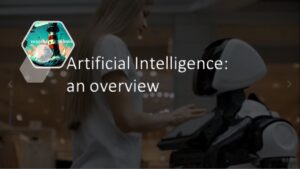
anything useful, in the easiest way

anything useful, in the easiest way
Artificial Intelligence: An Overview
Artificial intelligence (AI) has become a buzzword in recent years, with many industries and individuals excited about its potential to revolutionize the way we live and work. But what is AI, and how does it work?
In its simplest form, AI refers to the ability of machines to perform tasks that would typically require human intelligence. These tasks can range from simple calculations to complex decision-making processes, such as speech recognition, image analysis, and natural language processing. The technology behind AI includes machine learning, natural language processing, and deep learning, which allow machines to learn from data and improve their performance over time.

Applications of AI
AI has the potential to transform numerous industries, including healthcare, finance, transportation, manufacturing, and more. In healthcare, AI can help doctors diagnose diseases, predict patient outcomes, and even develop personalized treatment plans. In finance, AI can be used to identify fraudulent transactions, assess credit risk, and develop trading strategies. In transportation, AI can help optimize routes, reduce traffic congestion, and improve vehicle safety. In manufacturing, AI can help automate production processes, optimize supply chains, and improve product quality.
s.
Advantages of AI
One of the main advantages of AI is its ability to analyze vast amounts of data quickly and accurately, enabling faster and more informed decision-making. AI can also perform tasks with greater efficiency and accuracy than humans, freeing up time for people to focus on more complex and creative tasks. Additionally, AI has the potential to improve the quality of life for individuals through healthcare, education, and other fields.
Risks of AI
Despite its potential benefits, AI also poses several risks. One of the biggest concerns is the potential for AI to be used maliciously, such as in cyberattacks or the development of autonomous weapons. There is also the risk of AI displacing human workers, particularly in industries that rely heavily on manual labor. Additionally, there are concerns about bias in AI systems, as they may reflect the biases of their creators or the data on which they are trained.
Functions where AI can replace humans
AI has the potential to replace humans in tasks that are repetitive or dangerous. For example, in manufacturing, AI can be used to automate assembly line processes or perform quality control inspections. In transportation, self-driving cars have the potential to reduce accidents caused by human error. In finance, AI can replace human traders and analysts in some areas. In healthcare, AI can assist doctors in diagnosing diseases and analyzing medical images.
Functions where AI cannot replace humans
Despite its potential, there are certain areas where AI cannot replace humans. For example, AI lacks the empathy and creativity that humans possess, making it difficult for machines to understand the nuances of human emotions and experiences. Additionally, AI is not yet capable of making ethical or moral judgments, and may not always make decisions that align with human values.
Conclusion
In conclusion, AI has the potential to revolutionize numerous industries and improve the quality of life for individuals. However, it also poses several risks that must be addressed to ensure its safe and ethical development. As the field of AI continues to evolve, it will be important to consider the potential benefits and risks of this technology and work to develop policies and regulations that promote its responsible use
Thank you for reading us.
“so useful to know” team